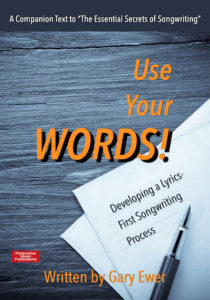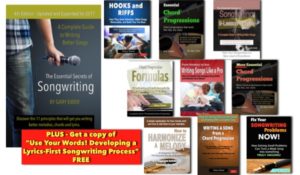 The following is an excerpt from Chapter 3 of “Use Your Words! Developing a Lyrics-First Songwriting Process.” That eBook is currently a free add-on to “The Essential Secrets of Songwriting 10-eBook Bundle.”
The following is an excerpt from Chapter 3 of “Use Your Words! Developing a Lyrics-First Songwriting Process.” That eBook is currently a free add-on to “The Essential Secrets of Songwriting 10-eBook Bundle.”
Poems don’t always make good lyrics, if only because the emotional ups and downs of a poem are often subtler than is required in pop genres. Additionally, the form of poetry doesn’t often match up with the typical forms we see with pop songs. But poetry can work well if some or all of the following is present:
- words with an easily-felt pulse;
- words that are in common, everyday usage;
- imagery that works well in a musical setting;
- a sense of emotional ebb and flow.
If you are a poet, then you have control over these factors, and so it can be much easier to create poetry that you plan to use as a song lyric. But searching through centuries of poetry now in the public domain can yield exciting material that will serve you well. You likely know that McCartney’s “Golden Slumbers” from the “Abbey Road” album uses a chorus lyric written by English poet and dramatist Thomas Dekker (1572-1632).
Using a public domain poem can be like discovering an old treasure chest full of jewels, all there for the taking. Because copyright typically expires 70 years after the death of the copyright holder, you usually just need to check a few dates to ensure legalities. But from time to time copyright can be renewed by the holder, and so this is a warning to you that you must do your research if you plan to use someone else’s poetry.
The Process
- Read the poem until you have it memorized. You’ll thank me for this tip someday. When you know a poem so well that you can recite it from memory, you are well placed to discover all the things you need to know about it: its structure, rhyming scheme, natural pulse, and so on. And those characteristics are often best discovered when calling the poem to mind, more so than reading it off a sheet of paper.
- Say the poem to yourself in many different ways. Doing this means finding the intrinsic beat and pulse of the words. Since your song is going to likely use a strong beat/weak beat pattern – 4/4 time, most likely – try to say the poem while tapping your foot. You’ll need to experiment with this quite a bit, but it is usually a fun kind of experimenting. Elongate some words, shorten others, and try to find the most natural way of reciting the words of the poem.
- Resist the urge to change words. This is certainly not to say that you can’t change words in a public domain poem, but take it as a challenge to use it as the author penned it, wherever possible. McCartney changed the words of “Golden Slumbers” from “Sleep, pretty wantons” to “Sleep, pretty darling,” and that was of course to use a word that was more in common usage – darling –than the antiquated “wantons.”
- Examine the structure of the poem for a possible chorus or refrain. Some poems will naturally have a refrain as part of its formal design, but that’s not common. However, you may notice that parts of the poem are just right for repetition in a chorus-kind of way:
- The lines trigger an emotional response;
- The words are in common, everyday usage;
- The rhythm of the words are clear, aligning in a strong beat/weak beat configuration.
- Pick the lines that assemble themselves well into a verse structure. Many poems will be long enough that setting the entire work is impractical. To choose lines of the poem that work as a poem, you need to start by getting a good idea of the story or circumstance being described therein. Songs may actually contain several story lines: one main one, with several subordinate stories or issues. Pick lines or sections that focus in on one storyline, particularly if the song you’re writing is in one of the pop genres; you need something that sounds complete in 3-5 minutes.
- Read your chosen verse lines, paying close attention to how they work with your chosen chorus. Remember that the chorus gets repeated, but each verse will use different lines. They all need to move smoothly to the chorus, and the chorus needs to sound right when followed by each verse.
 Written by Gary Ewer. Follow Gary on Twitter.
Written by Gary Ewer. Follow Gary on Twitter.
“The Essential Secrets of Songwriting” eBook bundle includes“Use Your Words! Developing a Lyrics-First Songwriting Process”. Discover the secrets of making the lyrics-first songwriting process work for you.












Pingback: The Daily Muse – May 8th, 2020 | All About Songwriting